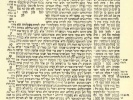
Sacred Texts Judaism Talmud Index Previous Next


Babylonian Talmud, Book 2: Tracts Erubin, Shekalim, Rosh Hashana, tr. by Michael L. Rodkinson, [1918], at sacred-texts.com
THIS Tract, virtually the third of the Sabbath series, treats of subjects similar to those discussed in the first two. The main point of. difference is, that most of the laws laid down in the preceding two volumes are founded on biblical behests, while those instituted in the present volume are of purely rabbinical origin, notwithstanding the assertion of a solitary individual who appears in the course of a debate and declares that the legal-limit branch of the Erub is a biblical enactment.
A remarkable feature of the Tract is the exposition of the manner in which the shrewd sages circumvene the rigorous prohibitions contained in the Tract Sabbath and how they take advantage of every loophole afforded them through imperfections in the law, at the same time avoiding any palpable infraction of the law itself.
As already explained in the introduction to Volume I., the restrictions with which the Sabbath was surrounded had their unquestionable political import, but their very rigor made the sages, than whom none knew the people better, doubt whether enforcement and still less voluntary observance could ever be possible. It became necessary, therefore, to find some way of modifying the law, not directly, but by the institution of other in a measure counteracting laws. The solution for this problem presented itself in the "Erub" (literally "commixture") ordinances, the first results of which were to bring about a distinction between the different kinds of ground inhabited by man. Lines of demarcation between public, unclaimed, and private ground and ground which was under no particular jurisdiction were strictly drawn. Whatever ground, however, could be made by hook or crook to come under the category of private ground was eagerly included, as in the latter things could be carried about at will. In order, therefore, to have as much private ground as possible, each man having an interest in public ground would relinquish or transfer his right to his neighbor and thus make it communal or private property. Of course, this could be
done only among Israelites, and where a Gentile had an interest in a piece of coveted ground, his share had to be bought outright.
It was this desire to be in the same neighborhood, yea, even on the same grounds, that laid the foundation of the subsequent Ghettos, still flourishing in most of the large cities of the world. How this communal living was fostered may be readily understood, when it is stated that the sages permitted the execution of a written instrument in Palestine an the Sabbath, under ordinary circumstances a grave offence, where a piece of property had to be purchased from a Gentile for communal purposes. (See Gitin, 8b, and Schulchan Aruch Orach Chaym, 306, §11.)
The name of this Tract may be said to have a certain significance. The Hebrew word "Erub" has a variety of meanings, among them "commixture," as stated, "agreeable," "secure," and "safeguard." As the discussions in the Tract will demonstrate, either one of these meanings may be applied to the appellation of the Tract and still express the purpose of the laws ordained. By those laws the observance of the Sabbath was made "secure," they proved a "safeguard" against "amalgamation" or "mingling" with other nations, and by virtue of the modification to the laws of Sabbath which was brought about, the observance of the Sabbath was made more "agreeable." Several other meanings might be utilized in the same manner, but lest they seem far-fetched they are omitted.
Another peculiarity of this Tract is that under no circumstances and on no occasion is the derivation of a law enacted in this particular Tract inquired into, and unlike other tracts there will not be found a single query as to where the Mishna derives the law. For want of other sources the institution of the Erub has been attributed to King Solomon, vide page 51.
The main subjects of discussion in the following pages will be how this Erub shall be effected, what materials shall be used to bring about a commixture, how entries (by which is meant the entry to a court or a yard where an aggregation of families reside) are to be arranged, and the like.
Altogether there are four kinds of Erubin, only three of which will be discussed in this treatise. They are: The combining of courts, the combining of limits, and the combining of streets, also known as junction. The other commixture is called combining of cookery, which will be treated at length in Tract Yom Tob.
The combining of courts deals with the regulations by the observance of which various houses standing in one court are joined together into one common ground, thus enabling the householders to carry and convey articles to and from one another. The combining of limits treats of the regulations through which the distance of two thousand ells, beyond which no Israelite is allowed to travel on the Sabbath, may be legally extended.
The combining of streets treats of the rules to be observed in the case of narrow streets and public places which can be turned into private ground under certain conditions.
Finally, it may be well to add that, of all the difficult and complicated treatises in the Talmud, the Tract Erubin is by far the most difficult, and in a great many places almost incomprehensible to other than the most careful students.
THE EDITOR.
NEW YORK, September, 1897.